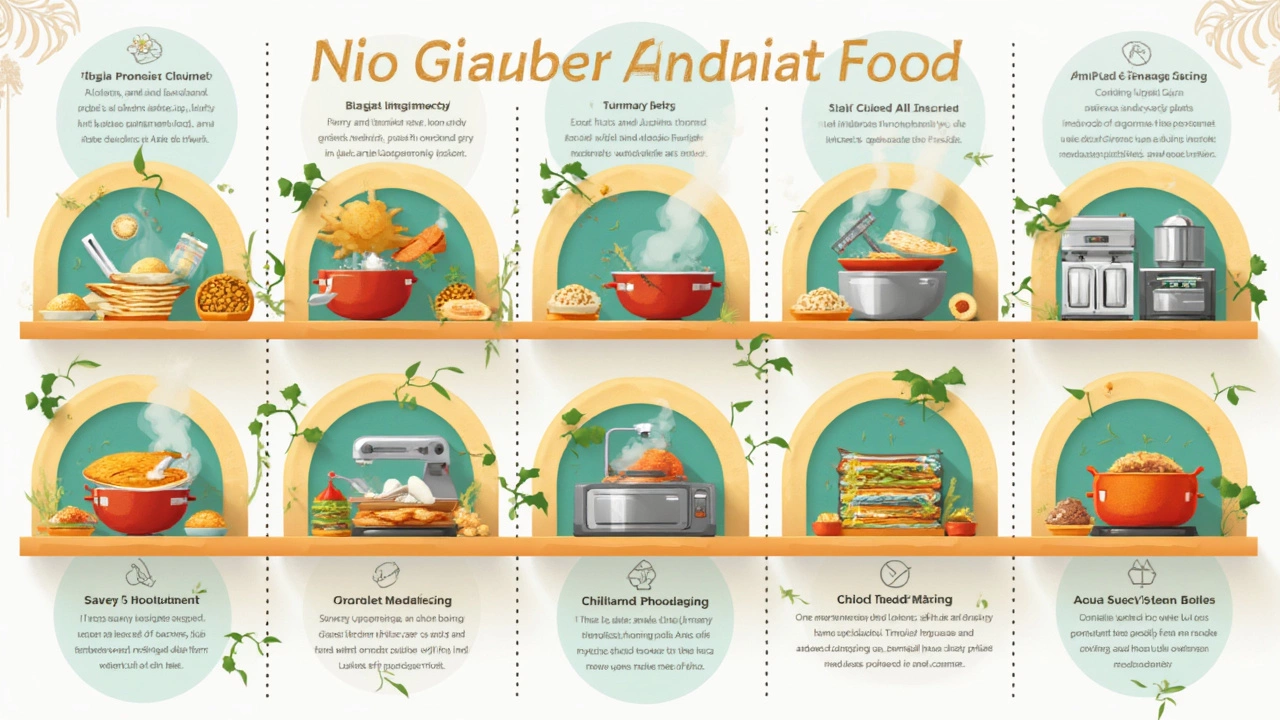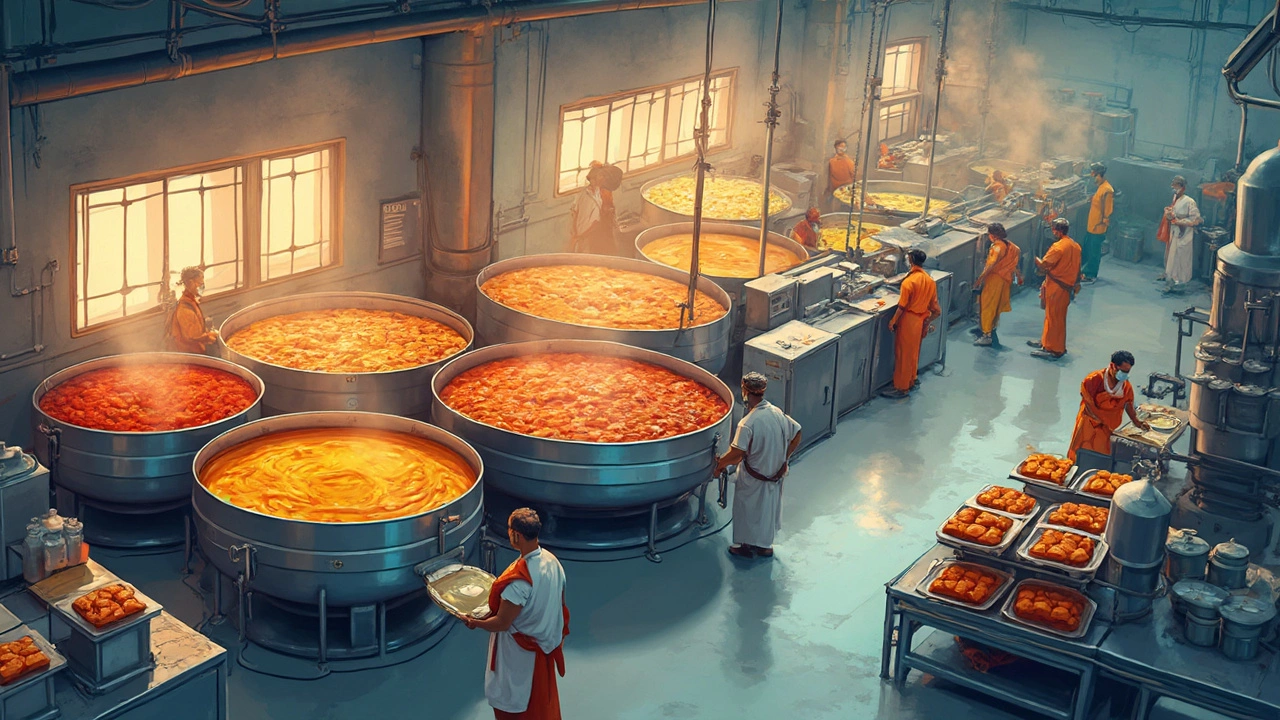Ever think about what actually happens to raw ingredients before they land on your plate as a tasty snack, a loaf of bread, or even ketchup? It all comes down to a handful of basic steps, repeated in different ways. These are called unit operations, and they’re the nuts and bolts of making food on a big scale.
Think about boiling, chopping, mixing, or packing—every time you see a food factory on TV with huge machines, those machines are doing one or more of these unit operations. Each step focuses on a simple goal. Maybe it’s grinding coffee beans, cooking milk, or chilling soda cans. The trick is to get the same result every time, no matter how big the batch is.
Getting these steps right not only keeps your food safe and fresh, but also saves time and money for the people making it. Even small changes in how food is heated, mixed, or stored can change the taste, texture, or shelf life. That’s why big food brands spend so much time and money testing their unit operations—because nobody wants mushy chips or spoiled cheese. But these ideas aren’t just for giant factories; you can use some of them in your own kitchen if you know what to look for.
- What Are Unit Operations?
- Main Types Found in Food Processing
- Why Unit Operations Matter
- Spotting and Fixing Common Problems
What Are Unit Operations?
When people talk about unit operations in food processing, they mean the basic steps or tasks that turn raw stuff into an end product. Think of them as the routines that happen in almost every food factory or kitchen, like heating, cooling, grinding, or mixing. Each operation does just one thing, but when you stack a bunch together, you get everything from bread to chocolate bars.
These steps aren’t random. They’re broken down so you can control each part and get the same result every time. For example, in a potato chip plant, potatoes go through washing, peeling, slicing, frying, and packing—each of those is its own unit operation.
Here's a simple breakdown:
- Mechanical operations: Things like cutting, mixing, or separating solids from liquids. If you’ve ever used a blender, you’ve done a mechanical operation.
- Thermal operations: Anything that uses heat or cold: cooking, pasteurizing milk, or freezing vegetables.
- Chemical operations: Changing food using reactions, like when you ferment yogurt or mature cheese with bacteria.
The interesting part? It’s not just about the end food. Using the right unit operation keeps things safe, saves energy, and reduces waste. According to a 2023 food tech report, food manufacturers that carefully optimized their unit operations cut production costs by up to 14% in a year. Smart tweaks matter.
Most foods need at least two or three different unit operations. For example, making juice at home already combines mechanical (blending) and thermal (if you pasteurize). Industrial setups just use bigger, faster versions of the same routines—scaling up from your kitchen to produce thousands of bottles per hour.
| Unit Operation | Common Example in Food |
|---|---|
| Heating | Baking bread |
| Mixing | Making sauces |
| Drying | Creating powdered milk |
| Filtration | Clarifying juice |
Understanding unit operations is like learning the basic moves in sports. Master them, and suddenly you can play just about any game—or in this case, make almost any food product.
Main Types Found in Food Processing
When you look behind the curtain in a food factory, you’ll notice that most steps boil down to a handful of classic unit operations. They’ve got odd names, but once you get the hang of them, a lot of things start to make sense. Here are the big ones you’ll see everywhere, whether you’re making cookies or cheese puffs:
- Mixing and Blending: This step shows up in almost every food you know. It’s about distributing ingredients so you don’t get one bite with all the salt and another with all the sugar. Industrial mixers can hold hundreds of kilos at a time, and some use special blades or paddles to get things just right.
- Heat Processing: Basically, any time you cook something at scale, you’re heat processing. This can be baking, boiling, steaming, or frying. The goal is often to make food safe by killing microbes, but it also changes how things taste and feel.
- Separation: Think of removing shells from nuts, sifting flour, or filtering juice. This is all about keeping what you want and ditching what you don’t. Machines for this are everywhere in the business, and they’re fast—some can sort tons per hour.
- Size Reduction: You can’t bite a whole potato in a bag of chips, right? Crushing, grinding, slicing, and dicing all fall under size reduction. The size and shape totally affect crunch, texture, and even how food cooks.
- Drying and Evaporation: Removing water is a game-changer for shelf life. Powders like instant coffee or soup mixes go through major drying steps, often using hot air or even special vacuum equipment.
- Packaging: Not just for looks—packaging protects food from germs, keeps out air, and can prevent spills or leaks. Some lines fill and seal over a hundred packs each minute.
These steps almost always show up in every big food factory, but even home kitchens use them in small ways—mixing batter, boiling water for pasta, or putting leftovers in a Tupperware. The scale is different, but the basics are the same.
| Food Product | Main Unit Operations |
|---|---|
| Potato Chips | Washing, Slicing, Frying, Seasoning, Packaging |
| Pasteurized Milk | Separation, Pasteurization (heating), Homogenization, Packaging |
| Bread | Mixing, Fermentation, Baking, Slicing, Packaging |
Knowing how food production really works with these building blocks can help you understand labels better or even spot when something's off with what you buy at the store.

Why Unit Operations Matter
If you walk into any food production plant, unit operations aren’t just boxes to check—they’re at the core of safety, taste, efficiency, and even the price of the final product. Every single unit operation matters because skipping or messing up one step can seriously mess up what you get at the store or in your school lunch.
Let’s get real: nobody wants gritty chocolate, soggy cereal, or bread that molds in a day. The way foods are heated, cooled, chopped, or even just sealed in a bag comes down to getting those food processing steps just right. For example, the pasteurization step in milk production is a classic unit operation. Without it, a glass of milk could harbor dangerous bacteria. Another example? Injecting air into ice cream—this is called overrun. Get that wrong, and you end up with dense, icy gloop instead of smooth, creamy ice cream.
Quality control is another big deal. Food production isn’t just about taste. It’s also about keeping food safe for weeks or months. That means tracking temperature, moisture, and time during every stage. For instance, check out this breakdown for sliced bread:
| Unit Operation | Why It Matters |
|---|---|
| Baking | Ensures bread is cooked inside and out |
| Cooling | Prevents soggy slices |
| Slicing | Makes each piece even and ready to package |
| Packing | Keeps bread fresh and mold-free |
Efficiency is another reason to care about unit operations, especially in big food technology factories pumping out thousands of products a day. A small tweak—like speeding up a mixer or changing the chopping blade—can mean less waste or more output. In 2023, one large snack company cut production costs by 10% just by optimizing their frying and packaging steps. That’s big money, and it often means lower prices at the store.
If you’re into making your own food at home, knowing about unit operations can help, too. Want better jam? Pay attention to things like heat, time, and stirring—just like the pros. That’s how you get the results you want, every time.
Spotting and Fixing Common Problems
If you’ve wondered why bread sometimes goes dense or why chips get soggy after a day, you’re already halfway to understanding common headaches in food processing. A lot of issues in food production come from unit operations that don’t run quite right. Catching problems early and knowing what to tweak can save a ton of waste and keep food tasting like it should.
One of the biggest hiccups? Temperature control during heating or cooling. If dairy isn’t heated enough during pasteurization, harmful bacteria might survive and spoil the milk. But if it’s heated too much, you lose the fresh flavor and destroy vitamins. The same goes for chips—too little frying time leaves them chewy, too much and you’ve made them bitter and brittle.
Mixing and blending can be surprisingly tricky in unit operations. Uneven mixing can leave dry patches in cakes or clumps in sauces, which is why many factories use computer-controlled mixers to keep things spot-on. Even something simple, like not scraping down the mixing bowl, can lead to off flavors or weird textures.
Packaging is another spot where problems pop up. Faulty seals on bags let in air, and suddenly chips lose their crunch or bread gets moldy fast. Newer machines use sensors to check every single package for leaks, but plenty of small producers still do spot checks by hand.
Catching these problems usually comes down to three things:
- Careful monitoring with thermometers, sensors, and visual checks
- Standardizing recipes and settings to keep batches consistent
- Staff training—if people spot issues early, it stops whole batches from going wrong
If you’re curious how these small things add up, here’s a peek at the cost per problem in modern food production:
| Problem | Common Cause | Typical Cost per Batch |
|---|---|---|
| Bread too dense | Under-mixing or wrong yeast temp | $480 (lost batch) |
| Soggy chips | Poor frying time or humidity | $340 (spoiled inventory) |
| Milk spoilage | Poor pasteurization | $1,200 (recall risk) |
| Moldy packaged food | Faulty package seal | $200 (waste + recall) |
Dialing in unit operations takes patience, lots of sensors, and being ready to tweak temperatures, times, and machine settings on the fly. But the payoff is less wasted food, happier customers, and a way easier life for everyone running the show.
